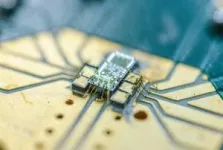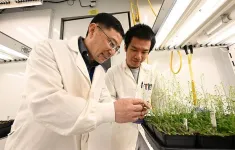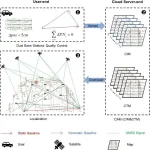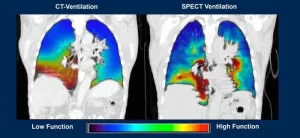(Press-News.org) Researchers at the University of Bristol have made an important breakthrough in scaling quantum technology by integrating the world’s tiniest quantum light detector onto a silicon chip.
A critical moment in unlocking the information age was when scientists and engineers were first able to miniaturise transistors onto cheap micro-chips in the 1960s.
Now, for the first time, University of Bristol academics have demonstrated the integration of a quantum light detector – smaller than a human hair – onto a silicon chip, moving us one step closer to the age of quantum technologies using light.
Making high performance electronics and photonics at scale is fundamental to realizing the next generation of advanced information technologies. Figuring out how to make quantum technologies in existing commercial facilities is an ongoing international effort being tackled by university research and companies around the world.
It could prove crucial for quantum computing to be able to make high performance quantum hardware at scale due to the vast amount of components anticipated to build even a single machine.
In pursuit of this goal, researchers at the University of Bristol have demonstrated a type of quantum light detector that is implemented on a chip with a circuit that occupies 80 micrometers by 220 micrometers.
Critically, the small size means the quantum light detector can be fast, which is key to unlocking high speed quantum communications and enabling high speed operation of optical quantum computers.
The use of established and commercially accessible fabrication techniques helps the prospects for early incorporation into other technologies such as sensing and communications.
“These types of detectors are called homodyne detectors, and they pop up everywhere in applications across quantum optics” explains Professor Jonathan Matthews, who led the research and is Director of the Quantum Engineering Technology Labs. “They operate at room temperature, and you can use them for quantum communications, in incredibly sensitive sensors — like state-of-the-art gravitational wave detectors — and there are designs of quantum computers that would use these detectors.”
In 2021 the Bristol team showed how linking a photonics chip with a separate electronics chip can increase speed of quantum light detectors — now with a single electronic-photonic integrated chip, the team have further increased speed by a factor of 10 whilst reducing footprint by a factor of 50.
While these detectors are fast and small, they are also sensitive.
“The key to measuring quantum light is sensitivity to quantum noise” explains author Dr Giacomo Ferranti. “Quantum mechanics is responsible for a minute, fundamental level of noise in all optical systems. The behaviour of this noise reveals information about what kind of quantum light is travelling in the system, it can determine how sensitive an optical sensor can be, and it can be used to mathematically reconstruct quantum states. In our study it was important to show that making the detector smaller and faster did not block its sensitivity for measuring quantum states.”
The authors note that there is more exciting research to do in integrating other disruptive quantum technology hardware down to the chip scale. With the new detector, the efficiency needs to improve, and there is work to be done to trial the detector in lots of different applications.
Professor Matthews added: “We built the detector with a commercially accessible foundry in order to make its applications more accessible. While we are incredibly excited by the implications across a range of quantum technology, it is critical that we as a community continue to tackle the challenge of scalable fabrication of quantum technology. Without demonstrating truly scalable fabrication of quantum hardware, the impact and benefits of quantum technology will be delayed and limited.“
The paper: “A Bi-CMOS electronic photonic integrated circuit quantum light detector” is published today in Science Advances: https://www.science.org/doi/10.1126/sciadv.adk6890
END
University of Bristol researchers develop world’s smallest quantum light detector on a silicon chip
Embargoed: Not for Release Until 2:00 pm U.S. Eastern Time Friday, 17 May 2024
2024-05-17
ELSE PRESS RELEASES FROM THIS DATE:
Gut bacteria boost immune response to fight tumors
2024-05-17
Roughly one in five cancer patients benefits from immunotherapy – a treatment that harnesses the immune system to fight cancer. Such an approach to beating cancer has seen significant success in lung cancer and melanoma, among others. Optimistic about its potential, researchers are exploring strategies to improve immunotherapy for cancers that don’t respond well to the treatment, with the hope of benefiting more patients.
Now, researchers at Washington University School of Medicine in St. Louis have found, in ...
How heatwaves are affecting Arctic phytoplankton
2024-05-17
The basis of the marine food web in the Arctic, the phytoplankton, responds to heatwaves much differently than to constantly elevated temperatures. This has been found by the first targeted experiments on the topic, which were recently conducted at the Alfred Wegener Institute’s AWIPEV Station. The phytoplankton’s behaviour primarily depends on the cooling phases after or between heatwaves, as shown in a study just released in the journal Science Advances.
Heatwaves, which we’ve increasingly seen around the globe in recent years, are also becoming more and ...
NUS scientist Professor Lim Chwee Teck elected Fellow of the Royal Society
2024-05-17
Professor LIM Chwee Teck, Director of the Institute for Health Innovation & Technology at the National University of Singapore (NUS iHealthtech) and NUSS Professor, has been elected to the prestigious Fellowship of the Royal Society, in recognition of his invaluable contributions to science.
The Royal Society is the world's oldest and most esteemed scientific academy in continuous existence, as well as the United Kingdom’s national academy of sciences. Fellows are elected annually, and candidates are evaluated based on their exceptional achievements in science. This ...
Modern plant enzyme partners with surprisingly ancient protein
2024-05-17
UPTON, N.Y. — Scientists from the U.S. Department of Energy’s (DOE) Brookhaven National Laboratory have discovered that a protein responsible for the synthesis of a key plant material evolved much earlier than suspected. This new research explored the origin and evolution of the biochemical machinery that builds lignin, a structural component of plant cell walls with significant impacts on the clean energy industry.
When the first land plants emerged from aquatic environments, they needed to adapt in order to survive.
Chang-Jun Liu, a senior scientist in Brookhaven’s Biology ...
Ion irradiation offers promise for 2D material probing
2024-05-17
Two-dimensional materials such as graphene promise to form the basis of incredibly small and fast technologies, but this requires a detailed understanding of their electronic properties. New research demonstrates that fast electronic processes can be probed by irradiating the materials with ions first.
A collaboration involving researchers at the University of Illinois Urbana-Champaign and the University of Duisburg-Essen has shown that when graphene is irradiated with ions, or electrically charged atoms, the electrons that are ejected ...
Scientists develop new geochemical ‘fingerprint’ to trace contaminants in fertilizer
2024-05-17
DURHAM N.C. – An international team of scientists has uncovered toxic metals in mineral phosphate fertilizers worldwide by using a new tool to identify the spread and impact of such contaminants on soil, water resources, and food supply.
“While mineral phosphate fertilizers are critical to boost global sustainable agriculture and food security, we found high levels of toxic metals in many fertilizers worldwide,” said Avner Vengosh, chair of the Earth and Climate Sciences division at Duke University’s Nicholas School of the Environment. “Our study developed a new method to identify sources and impacts of these metals on the environment.” Those ...
From the road to the cloud: leveraging vehicle GNSS raw data for spatial high-resolution atmospheric mapping and user positioning
2024-05-17
Innovative Global Navigation Satellite System (GNSS) positioning technologies harness massive vehicle-generated data to create high-resolution atmospheric delay correction maps, significantly enhancing Global Positioning System (GPS) accuracy across varied spatial scales. This new method exploits real-time, crowd-sourced vehicle GNSS raw data, refining traditional GPS applications and presenting a cost-effective solution for precise positioning.
The quest for enhanced Global Navigation Satellite System (GNSS) accuracy has been hindered ...
Study suggests that air pollution promotes inflammation in the brain, accelerating cognitive decline and increasing risk of dementia
2024-05-17
Results from new study suggests that long-term exposure to air pollution leads to increased risk in dementia in Denmark.
"We also find association with noise, but this seems to be explained by air pollution primarily. Our study is in line with growing international knowledge on this topic." says Professor at Section of Environmental Health Zorana Jovanovic Andersen.
This is an important finding which adds that air pollution, beyond well-known effects on respiratory and cardiovascular system, also has major impacts on our brain, promoting inflammation in the brain, accelerating cognitive decline, and increasing ...
New imaging software improves lung diagnosis for 30% of patients who can't tolerate contrast dye; has added diagnostic benefits for all patients
2024-05-17
Southfield, Mich., May 17, 2024 – For up to 30% of patients who are allergic to medical contrast dye or have a dye restriction because of other health conditions, they might find that it takes longer to get a diagnosis when it comes to life-threatening lung issues such as pulmonary embolism. That's because imaging methods that detect lung problems but don't use contrast dye aren't as accurate and can be more time-consuming to administer.
Now, new imaging software, developed by pulmonologist Girish Nair, M.D., with Corewell Health William Beaumont University Hospital in Royal Oak, Michigan, and biomedical ...
A trial HIV vaccine triggered elusive and essential antibodies in humans
2024-05-17
DURHAM, N.C. – An HIV vaccine candidate developed at the Duke Human Vaccine Institute triggered low levels of an elusive type of broadly neutralizing HIV antibodies among a small group of people enrolled in a 2019 clinical trial.
The finding, reported May 17 in the journal Cell, not only provides proof that a vaccine can elicit these antibodies to fight diverse strains of HIV, but that it can also initiate the process within weeks, setting in motion an essential immune response.
The vaccine candidate targets an area on the HIV-1 outer envelope called the membrane proximal external region (MPER), which ...
LAST 30 PRESS RELEASES:
University of Oklahoma researcher awarded funding to pursue AI-powered material design
Exploring how the visual system recovers following injury
Support for parents with infants at pediatric check-ups leads to better reading and math skills in elementary school
Kids’ behavioral health is a growing share of family health costs
Day & night: Cancer disrupts the brain’s natural rhythm
COVID-19 vaccination significantly reduces risk to pregnant women and baby
The role of vaccination in maternal and perinatal outcomes associated with COVID-19 in pregnancy
Mayo Clinic smartwatch system helps parents shorten and defuse children's severe tantrums early
Behavioral health spending spikes to 40% of all children’s health expenditures, nearly doubling in a decade
Digital cognitive behavioral treatment for generalized anxiety disorder
Expenditures for pediatric behavioral health care over time and estimated family financial burden
Air conditioning in nursing homes and mortality during extreme heat
The Alps to lose a record number of glaciers in the next decade
What makes a good proton conductor?
New science reporting guide published for journalists in Bulgaria
New international study reveals major survival gaps among children with cancer
New science reporting guide published for journalists in Turkey
Scientists develop a smarter mRNA therapy that knows which cells to target
Neuroanatomy-informed brain–machine hybrid intelligence for robust acoustic target detection
Eight SwRI hydrogen projects funded by ENERGYWERX
The Lundquist Institute and its start-up company Vitalex Biosciences Announces Strategic Advancement of Second-Generation fungal Vaccine VXV-01 through Phase 1 Trials under $40 Million Competitive Con
Fine particles in pollution are associated with early signs of autoimmune disease
Review article | Towards a Global Ground-Based Earth Observatory (GGBEO): Leveraging existing systems and networks
Penn and UMich create world’s smallest programmable, autonomous robots
Cleveland researchers launch first major study to address ‘hidden performance killer’ in athletes
To connect across politics, try saying what you oppose
Modulating key interaction prevents virus from entering cells
Project explores barriers to NHS career progression facing international medical graduates
Jeonbuk National University researchers explore the impact of different seasonings on the flavor perception of Doenjang soup
Two Keck Medicine of USC Hospitals named Leapfrog Top Teaching Hospitals
[Press-News.org] University of Bristol researchers develop world’s smallest quantum light detector on a silicon chipEmbargoed: Not for Release Until 2:00 pm U.S. Eastern Time Friday, 17 May 2024









